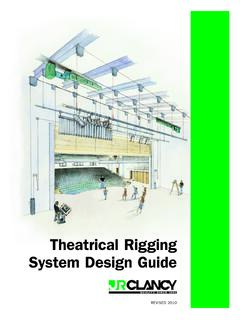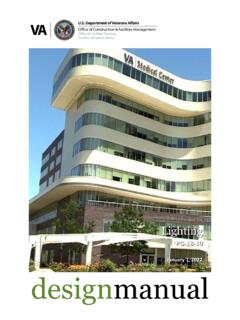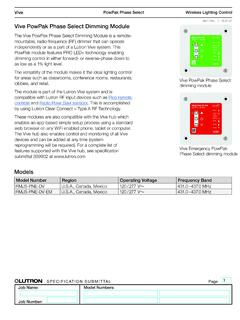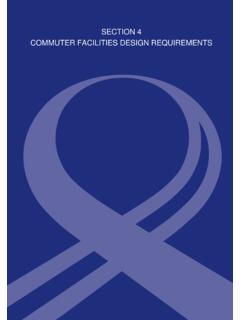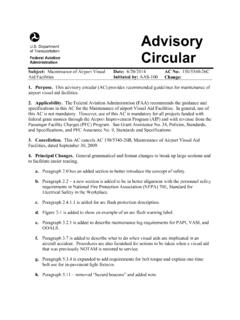Transcription of Orlight Guide on Emergency Lighting
1 FROM SOURCE TO SITEJuly 2013 Emergency Lighting Guide Web - Tel - 01707 663 883 Fax - 01707 663 882 Email - Office 21B Cranborne Industrial Estate | Cranborne Road | Potters Bar | Hertfordshire | EN6 3 JNOrlight Design Studio & Showroom The Plaza | 535 Kings Road | Chelsea | London | SW10 0 SZEmergency Lighting Guide FROM SOURCE TO SITE1 Sections 1. INTRODUCTION2. DEFINITIONS3. NEED FOR Emergency LIGHTING4. CURRENT, NEW LEGISLATION & POLICY5. Emergency Lighting DESIGN6. LOCATIONS Open areas Emergency exit and escape routes External areas in immediate vicinity of exits Lift cars Moving stairways and walkways Toilet facilities Switch rooms and Plant rooms Covered car parks7. DURATION OF BATTERY BACK-UP8.
2 LUMINANCE LEVELS9. PRODUCT CONFORMITY10. PHOTOMETRIC DATA & SPACING TABLES11. ESCAPE ROUTES12. EXIT SIGNS13. INSTALLATION14. WIRING SYSTEMS FOR CENTRAL POWER SYSTEMS15. Emergency Lighting TEST SWITCHES 16. COMMISSIONING & HANDOVER17. MAINTENANCE Checklist for existing installations Daily Monthly Annually 18. FREQUENTLY ASKED QUESTIONS Emergency Lighting Guide FROM SOURCE TO SITE21 INTRODUCTIONThis Guide has been written to offer practical guidance for contractors undertaking work on Emergency Lighting systems. It is not designed to replace any of the parts of BS 5266. The more detailed technical recommendations can be found in the actual standards. Anyone undertaking works on Emergency Lighting Systems should be in possession of the following British Standards:BS 5266-1:2011BS EN 1838:1999 (also numbered as BS 5266-7:1999)BS EN 50172:2004 (also numbered as BS 5266-8:2004)BS 7671:2008+Amd :2011 This Guide looks at these systems and offers some useful guidance and information on the use of the Guide is designed to explain the use of and interpret the recommendations of the British Standards, as it applies to the individuals and organisations that carry out the design, installation, commissioning and maintenance of Emergency Lighting 5266-1 was reviewed and reissued in 2011 and the previous 2005 edition has been withdrawn.
3 Also withdrawn is BS 5266-10:2008 the requirements and recommendations contained in this part of BS 5266 has now been combined within BS 5266-1:2011 Although often called Emergency Lighting , there are different types of Emergency Lighting systems and installations, which have different objectives and standards. This Guide covers: Emergency Lighting , Emergency escape Lighting , Emergency escape route Lighting , open area (often called anti-panic) Lighting High risk task area Lighting Guide FROM SOURCE TO SITE3 The purpose of Emergency Lighting is to ensure the safety Lighting is provided promptly, automatically and for a suitable time, in a specified area when the normal mains power supply to the usual Lighting installation overall objective of Emergency escape Lighting is to enable safe exit from a location and/or building in the event of failure of the mains normal objective of escape route Lighting is to enable the safe exit from a location or building for occupants by providing appropriate visual conditions and direction finding on escape routes, and in special locations, and to ensure that fire fighting and safety equipment can be readily located and used.
4 The objective of open area (anti-panic) Lighting is to reduce the likelihood of panic and to enable safe movement of occupants towards escape routes by providing appropriate visual conditions and direction finding. The objective of high risk task area Lighting is to contribute to the safety of people involved in a potentially dangerous process or situation and to enable proper shut down procedures to be carried out for the safety of other occupants of the location or the combination of different types of Emergency Lighting is likely to be needed in most buildings and a risk assessment should be carried out to identify the areas and locations, which will require Emergency Lighting and the type of installation varies from person to person, both in the amount of light required to perceive an object clearly and in the time taken to adapt to the changes in the illuminance level.
5 In general, older people need more light and take longer to adapt to A lower illuminance on hazard or escape anxiety and confusion can be alleviated by strategically placing Emergency Lighting luminaires and signs indicating the way out of a location or building. It is very important that exits are clearly signposted and are visible, whenever the location or building is Lighting Guide FROM SOURCE TO SITE42 DEFINITIONSIt is a good idea to familiarise yourselves with some of the definitions used within the Emergency Lighting design, installation, commissioning and maintenance routeA route designated for escape to a place of safety in the event of an escape route lightingThat part of Emergency escape Lighting provided to ensure that the means of escape can be effectively identified and safely used at all times when the premises are occupied.
6 Open area (anti-panic)Areas of undefined escape routes in halls or premises larger than 60m2 floor area or smaller areas if there is additional hazard such as use by a large number of exitA way out that is used during an exitThe terminal point of an escape Lighting Guide FROM SOURCE TO SITE5 Maintained Emergency luminaireLuminaire in which the Emergency Lighting lamps are energized at all times when normal Lighting or Emergency Lighting is Emergency luminaireLuminaire in which the Emergency Lighting lamps are in operation only when the mains supply to the normal Lighting battery durationDuration, in hours, of Emergency operation of the battery required for the duration of Emergency operationTime, in hours, as claimed by the manufacturer, that the rated Emergency lumen output is task area lightingThat part of Emergency escape Lighting that provides illumination for the safety of people involved in a potentially dangerous area, process or situation and to enable proper shut down procedures for the safety of the operator and other occupants of the Lighting Guide FROM SOURCE TO SITE63 NEED FOR Emergency LIGHTINGWhen the mains supply to the normal Lighting of premises fails, Emergency Lighting may be required.
7 Throughout this Guide , reference to Emergency Lighting covers Emergency escape Lighting in particular, but also includes any element of standby Lighting , which may be used for Emergency escape Lighting , and as determined by the risk Lighting Guide FROM SOURCE TO SITE7 Fig 1 Regulatory Reform (Fire Safety) Order 2005 Fig 2 Part B of the Building Regulations4 CURRENT, NEW LEGISTATION AND POLICYU nder the Management of Health and Safety at Work Regulations 1999, every employer is required to carry out a risk assessment to identify the risks to people who enter the employer s premises; the employer is required to take measures on the basis of the risk assessment to safeguard building occupants. These measures need to include the provision of safe means of escape, including, where necessary, Emergency Lighting , taking into account the needs of people with disabilities, in particular people with visual impairment.
8 Emergency Lighting is covered by various pieces of legislation and regulations. The major of these are: - 1) The Construction Products Directive. This is implemented by building control officers requirements are given in Approved Document B Fire Safety (Statutory)2) Regulatory Reform Order (Fire Safety) 2005 (Statutory)3) The Signs Directive (90/664) implemented in UK by Statutory Instrument 341 (Statutory)4) The Management of Health and Safety at Work Regulations 1999 (Statutory)You should ensure you are familiar with these legislative documents and regulations before undertaking any design or any work. These laws and regulations require that those who undertake work within these areas may be required to demonstrate competence. There has been much debate on how individuals and companies can demonstrate that they are competent to carry out the maintenance of Emergency Lighting installations.
9 1) Electricity at Work Regulations 1989 covers the issue of competence in Regulation ) Regulatory Reform (Fire Safety) Order 2005 covers the issue of competence in Clause person is to be regarded as competent where he/she has sufficient training and experience or knowledge along with additional qualities for them to assist in undertaking preventative and protective Lighting Guide FROM SOURCE TO SITE85 Emergency Lighting DESIGNAt the start of any Emergency Lighting design, the relevant information regarding the premises needs to be obtained either from drawings, a site survey or the building s responsible Design checklistThe following describe a typical list of actions, which would take place during an Emergency Lighting system design process. Examination of the risk assessment Duration of the Emergency Lighting Identify Emergency escape routes and take account of potential hazards Identify the locations of fire alarm call points.
10 Fire fighting equipment and fire safety signs Determine type of Emergency Lighting system Means of isolation for testing and/or maintenance Coordination/interface with luminaire manufacturers where main luminaires are to be converted into Emergency Lighting luminaires Identify the exit sign requirements Identify any high risk areas Open areas larger than 60m floor areas need to be identified Need for external illumination outside final exit doors and on a route to a place of Lighting Guide FROM SOURCE TO SITE9 The start of any design is to identify and agree the escape routes so the design will be engineered in accordance with EN 1838 (BS 5266-7).Plans or layout drawings showing the layout of the building and of all existing or proposed escape routes, fire alarm call points and fire fighting equipment, also indicating the positions of all structural items which may offer obstruction to escape should be provided before commencing system between interested parties the owner/developer and/or occupier of the premises, the architect, the consultant, the Lighting engineer, the installation contractor, the enforcing authorities ( the building control and fire authorities), and any other interested parties, should be arranged very early in the design stage.

